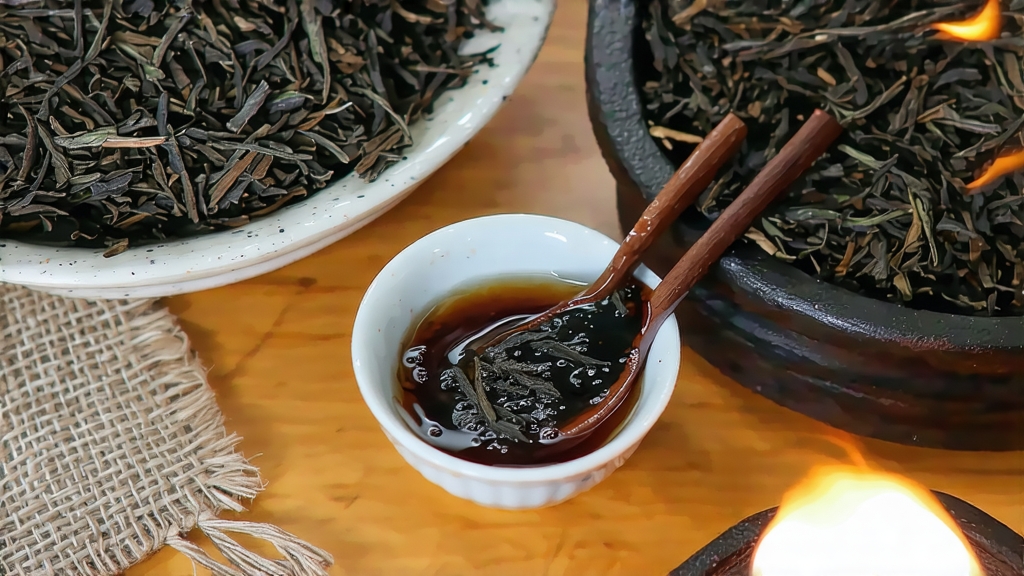
Long before English merchants coined the word “black tea,” Chinese mountain folk were already coaxing the first fully oxidized leaves from the granite crevices of northern Fujian. Locals called the tea Zheng Shan Xiao Zhong—“small leaf from the original mountain”—but the trading warehouses of Amoy (modern Xiamen) labeled the crates “Lapsang Souchong,” and the name stuck. Today, connoisseurs treat it as both a curiosity and a patriarch: the earliest style of hong cha (red tea) and the distant ancestor of every Assam breakfast blend or Ceylon high-grown bouquet you have ever tasted.
History: Smoke as Signature
The story begins around 1646, when Qing troops pushed southward through the Wuyi range. Retreating soldiers commandeered tea sheds, forcing farmers to speed-dry their harvest over open pine fires so they could flee before dawn. The accidental smoke infusion delighted the Dutch buyers waiting at the port; they paid double, and a new fashion was born. By the 1660s, Lapsang Souchong was riding East-India clippers to London coffeehouses, where Samuel Pepys noted its “strange, warme smokinesse” in his diary. Queen Victoria later made it her private indulgence, sealing its reputation as the aristocrat’s cup.
Terroir: One Canyon, Two Leaves
Authentic Lapsang comes only from the 600–1 200 m belt of the Tongmu Guan nature reserve, a fog-draped notch carved by the Nine-Bend River. The gorge’s diurnal swing—misty 18 °C dawns rising to 28 °C afternoons—slows oxidation and concentrates amino acids. The bushes themselves are not the ubiquitous Camellia sinensis var. assamica but a local var. sinensis clone known as cai cha, sporting tiny, pale-green leaves that look almost yellow when back-lit. Because the reserve is a UNESCO biosphere, no agro-chemicals are allowed; farmers mulch bamboo leaves to suppress weeds and invite insect-eating spiders into the canopy.
Two Families of Flavor
-
Traditional Smoke-Dried (Song Xing Zheng Shan Xiao Zhong)
The leaves wither over pine embers, roll, oxidize fully, then spend a final night on bamboo trays suspended above a pinewood hearth. The smoke is cool, 35–40 °C, so it perfumes rather than cooks the leaf. Result: a glossy, jet-black strip that smells like a cedar violin case soaked in single-malt whisky. -
Modern Unsmoked (Wu Xun Zheng Shan Xiao Zhong)
Since 2005, a new generation has catered to Chinese palates that prize honeyed sweetness over campfire. The same leaf is withered naturally, oxidized, then baked in electric ovens at 80 °C. The cup is russet, with notes of longan fruit and raw cacao, proving that Tongmu terroir alone can stand without its historic veil of smoke.
Craft: From Picking to Perfume
Harvest opens the first week of May, when two leaves and a bud still wear their spring down. The pluckers—mostly women wearing bamboo hats—work until 9 a.m., before mountain clouds thicken. Back at the shed, the leaves are loaded onto bamboo sieves set 1.5 m above a shallow pit of smoldering Masson pine. The fire is never allowed to flame; resin-rich logs are split pencil-thin so they smolder like incense. Over six hours the leaf loses 60 % moisture, turning limp and fragrant.
Rolling follows, done on 70-year-old cast-iron tables whose oak aprons creak in rhythm. Ten minutes of light pressure bruises the cells just enough to release catechins; the strips emerge tightly curled, like dark eyebrows. Oxidation happens in pine-wood boxes lined with wet cotton; the leaf pile is turned every 30 minutes to keep the temperature below 26 °C. After three hours the green has reddened to a rich mahogany.
Finally comes the “second smoke.” A brick-lined pit is topped with a bamboo rack; the tea rests here for eight hours while cooler smoke (30 °C) drifts upward. Master Chen Jianhua judges readiness by sound: when a handful of leaves rustles like autumn leaves, the batch is done. Total production